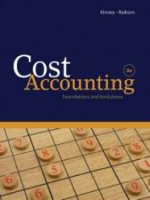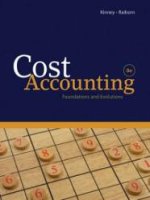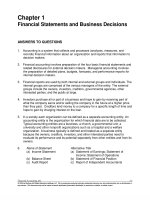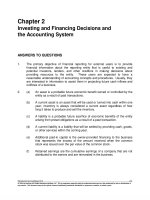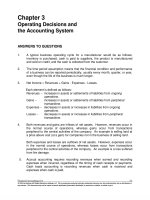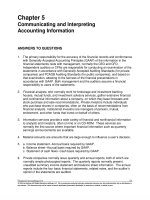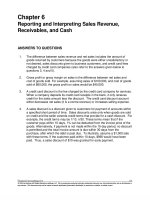Solution manual managerial accounting 8e by hansen mowen ch 11
Bạn đang xem bản rút gọn của tài liệu. Xem và tải ngay bản đầy đủ của tài liệu tại đây (261.48 KB, 44 trang )
To download more slides, ebook, solutions and test bank, visit
CHAPTER 11
COST-VOLUME-PROFIT ANALYSIS:
A MANAGERIAL PLANNING TOOL
QUESTIONS FOR WRITING AND DISCUSSION
1. CVP analysis allows managers to focus on
selling prices, volume, costs, profits, and
sales mix. Many different “what if” questions
can be asked to assess the effect on profits
of changes in key variables.
$30,000/$25 = 1,200 packages, or 2,400
units of A and 1,200 units of B.
2. The units-sold approach defines sales volume in terms of units of product and gives
answers in these same terms. The salesrevenue approach defines sales volume in
terms of revenues and provides answers in
these same terms.
3. Break-even point is the level of sales activity
where total revenues equal total costs, or
where zero profits are earned.
4. At the break-even point, all fixed costs are
covered. Above the break-even point, only
variable costs need to be covered. Thus,
contribution margin per unit is profit per unit,
provided that the unit selling price is greater
than the unit variable cost (which it must be
for break-even to be achieved).
5. Profit = $7.00 × 5,000 = $35,000
12.
Profit = 0.60($200,000 – $100,000) =
$60,000
13.
A change in sales mix will change the contribution margin of the package (defined by
the sales mix) and, thus, will change the
units needed to break even.
14.
Margin of safety is the sales activity in
excess of that needed to break even. The
higher the margin of safety, the lower the
risk.
15.
Operating leverage is the use of fixed costs
to extract higher percentage changes in
profits as sales activity changes. It is
achieved by increasing fixed costs while lowering variable costs. Therefore, increased
leverage implies increased risk, and vice
versa.
16.
Sensitivity analysis is a “what if” technique
that examines the impact of changes in underlying assumptions on an answer. A company can input data on selling prices, variable costs, fixed costs, and sales mix and set
up formulas to calculate break-even points
and expected profits. Then, the data can be
varied as desired to see what impact
changes have on the expected profit.
17.
By specifically including the costs that vary
with nonunit drivers, the impact of changes
in the nonunit drivers can be examined. In
traditional CVP, all nonunit costs are lumped
together as “fixed costs.” While the costs are
fixed with respect to units, they vary with respect to other drivers. ABC analysis reminds
us of the importance of these nonunit drivers
and costs.
6. Variable cost ratio = Variable costs/Sales.
Contribution margin ratio = Contribution
margin/Sales. Contribution margin ratio = 1
– Variable cost ratio.
7. Break-even revenues = $20,000/0.40 =
$50,000
8. No. The increase in contribution is $9,000
(0.30 × $30,000), and the increase in advertising is $10,000.
9. Sales mix is the relative proportion sold of
each product. For example, a sales mix of
3:2 means that three units of one product
are sold for every two of the second product.
10.
Packages of products, based on the expected sales mix, are defined as a single
product. Selling price and cost information
for this package can then be used to carry
out CVP analysis.
11.
Package contribution margin: (2 × $10) + (1
× $5) = $25. Break-even point =
347
To download more slides, ebook, solutions and test bank, visit
18.
JIT simplifies the firm’s cost equation since
more costs are classified as fixed (e.g., direct labor). Additionally, the batch-level variable is gone (in JIT, the batch is one unit).
Thus, the cost equation for JIT includes
fixed costs, unit variable cost times the
number of units sold, and unit product-level
cost times the number of products sold (or
related
cost
driver). JIT means that CVP analysis approaches the standard analysis with fixed
and unit-level costs only.
348
To download more slides, ebook, solutions and test bank, visit
EXERCISES
11–1
1.
Direct materials
Direct labor
Variable overhead
Variable selling expenses
Variable cost per unit
$3.90
1.40
2.10
1.00
$ 8.40
2.
Price
Variable cost per unit
Contribution margin per unit
3.
Contribution margin ratio = $5.60/$14 = 0.40 or 40%
4.
Variable cost ratio = $8.40/$14 = 0.60 or 60%
5.
Total fixed cost = $44,000 + $47,280 = $91,280
6.
Breakeven units = (Fixed cost)/Contribution margin
= $91,280/$5.60
= 16,300
$14.00
8.40
$5.60
349
To download more slides, ebook, solutions and test bank, visit
11–2
1.
Price
Less:
Direct materials
Direct labor
Variable overhead
Variable selling expenses
Contribution margin per unit
$12.00
$1.90
2.85
1.25
2.00
8.00
$4.00
2.
Breakeven units = (Fixed cost)/Contribution margin
= (44,000 + $37,900)/$4.00
= 20,475
3.
Units for target
4.
Sales (22,725 × $12)
Variable costs (22,725 × $8)
Contribution margin
Fixed costs
Operating income
= (44,000 + $37,900 + $9,000)/$4
= $90,900/$4
= 22,725
$ 272,700
181,800
$ 90,900
81,900
$ 9,000
Sales of 22,725 units does produce operating income of $9,000.
11–3
1.
Units = Fixed cost/Contribution margin
= $37,500/($8 – $5)
= 12,500
2.
Sales (12,500 × $8)
Variable costs (12,500 × $5)
Contribution margin
Fixed costs
Operating income
3.
Units = (Target income + Fixed cost)/Contribution margin
= ($37,500 + $9,900)/($8 – $5)
= $47,400/$3
= 15,800
$100,000
62,500
$ 37,500
37,500
$
0
350
To download more slides, ebook, solutions and test bank, visit
11–4
1.
Contribution margin per unit = $8 – $5 = $3
Contribution margin ratio = $3/$8 = 0.375, or 37.5%
2.
Variable cost ratio = $75,000/$120,000 = 0.625, or 62.5%
3.
Revenue = Fixed cost/Contribution margin ratio
= $37,500/0.375
= $100,000
4.
Revenue = (Target income + Fixed cost)/Contribution margin ratio
= ($37,500 + $9,900)/0.375
= $126,400
11–5
1.
Break-even units = Fixed costs/(Price – Variable cost)
= $180,000/($3.20 – $2.40)
= $180,000/$0.80
= 225,000
2.
Units = ($180,000 + $12,600)/($3.20 – $2.40)
= $192,600/$0.80
= 240,750
3.
Unit variable cost = $2.40
Unit variable manufacturing cost = $2.40 – $0.32 = $2.08
The unit variable cost is used in cost-volume-profit analysis, since it includes
all of the variable costs of the firm.
351
To download more slides, ebook, solutions and test bank, visit
11–6
1.
Before-tax income = $25,200/(1 – 0.40) = $42,000
Units = ($180,000 + $42,000)/$0.80
= $222,000/$0.80
= 277,500
2.
Before-tax income = $25,200/(1 – 0.30) = $36,000
Units = ($180,000 + $36,000)/$0.80
= $216,000/$0.80
= 270,000
3.
Before-tax income = $25,200/(1 – 0.50) = $50,400
Units = ($180,000 + $50,400)/$0.80
= $230,400/$0.80
= 288,000
11–7
1.
Contribution margin per unit = $15 – ($3.90 + $1.40 + $2.10 + $1.60) = $6
Contribution margin ratio = $6/$15 = 0.40 or 40%
2.
Breakeven Revenue = Fixed cost/Contribution margin ratio
= ($52,000 + $37,950)/0.40
= $224,875
3.
Revenue = (Target income + Fixed cost)/Contribution margin ratio
= ($52,000 + $37,950 + $18,000)/0.40
= $269,875
4.
Breakeven units = $224,875/$15 = 14,992 (rounded)
Or
Breakeven units = $89,950/$6 = 14,992 (rounded)
5.
Units for target income = $269,875/$15 = 17,992 (rounded)
Or
Units for target income = $107,950/$6 = 17,992 (rounded)
352
To download more slides, ebook, solutions and test bank, visit
11–8
1.
Sales mix is 2:1 (Twice as many videos are sold as equipment sets.)
2.
Product
Videos
Equipment sets
Total
Price
$12
15
Variable
–
Cost
$4
6
=
CM
$8
9
×
Sales
Mix
2
1
= Total CM
$16
9
$25
Break-even packages = $70,000/$25 = 2,800
Break-even videos
= 2 × 2,800 = 5,600
Break-even equipment sets = 1 × 2,800 = 2,800
3.
Switzer Company
Income Statement
For Last Year
Sales ...........................................................................................
Less: Variable costs .................................................................
Contribution margin..................................................................
Less: Fixed costs ......................................................................
Operating income ................................................................
$ 195,000
70,000
$ 125,000
70,000
$ 55,000
Contribution margin ratio = $125,000/$195,000 = 0.641, or 64.1%
Break-even sales revenue = $70,000/0.641 = $109,204
353
To download more slides, ebook, solutions and test bank, visit
11–9
1.
Sales mix is 2:1:4 (Twice as many videos will be sold as equipment sets, and
four times as many yoga mats will be sold as equipment sets.)
2.
Product
Videos
Equipment sets
Yoga mats
Total
Price
$12
15
18
–
Variable
Cost
$4
6
13
=
CM
$8
9
5
×
Sales
Mix
2
1
4
= Total CM
$16
9
20
$45
Break-even packages = $118,350/$45 = 2,630
Break-even videos
= 2 × 2,630 = 5,260
Break-even equipment sets = 1 × 2,630 = 2,630
Break-even yoga mats
= 4 × 2,630 = 10,520
3.
Switzer Company
Income Statement
For the Coming Year
Sales ...........................................................................................
Less: Variable costs .................................................................
Contribution margin..................................................................
Less: Fixed costs ......................................................................
Operating income ................................................................
$555,000
330,000
$225,000
118,350
$106,650
Contribution margin ratio = $225,000/$555,000 = 0.4054, or 40.54%
Break-even revenue = $118,350/0.4054 = $291,934
11–10
1.
Variable cost per unit = $5.60 + $7.50 + $2.90 + $2.00 = $18
Breakeven units = $75,000/($24 – $18) = 12,500
Breakeven Revenue = $24 × 12,500 = $300,000
2.
Margin of safety in sales dollars = ($24 × 14,000) – $300,000 = $36,000
3.
Margin of safety in units = 14,000 units – 12,500 units = 1,500 units
354
To download more slides, ebook, solutions and test bank, visit
11–11
1.
$35,000
$30,000
$25,000
$20,000
$15,000
$10,000
$5,000
$0
0
500
1,000
1,500
2,000
2,500
3,000
3,500
Units Sold
Break-even point = 2,500 units; + line is total revenue and x line is total costs.
355
To download more slides, ebook, solutions and test bank, visit
11–11 Continued
2.
a. Fixed costs increase by $5,000:
$40,000
$35,000
$30,000
$25,000
$20,000
$15,000
$10,000
$5,000
$0
0
500
1,000
1,500
2,000
Units Sold
Break-even point = 3,750 units
356
2,500
3,000
3,500
4,000
To download more slides, ebook, solutions and test bank, visit
11–11 Continued
b. Unit variable cost increases to $7:
$50,000
$40,000
$30,000
$20,000
$10,000
$0
0
500
1,000
1,500
2,000
2,500
Units Sold
Break-even point = 3,333 units
357
3,000
3,500
4,000
To download more slides, ebook, solutions and test bank, visit
11–11 Continued
c. Unit selling price increases to $12:
$50,000
$40,000
$30,000
$20,000
$10,000
$0
0
500
1,000
1,500
2,000
2,500
Units Sold
Break-even point = 1,667 units
358
3,000
3,500
4,000
To download more slides, ebook, solutions and test bank, visit
11–11 Continued
d.
Both fixed costs and unit variable cost increase:
$70,000
$60,000
$50,000
$40,000
$30,000
$20,000
$10,000
$0
0
1,000
2,000
3,000
4,000
5,000
Units Sold
Break-even point = 5,000 units
359
6,000
7,000
8,000
To download more slides, ebook, solutions and test bank, visit
11–11 Continued
3.
Original data:
$10,000
$0
0
500
1,000
1,500
2,000
-$10,000
Break-even point = 2,500 units
360
2,500
3,000
3,500
4,000
To download more slides, ebook, solutions and test bank, visit
11–11 Continued
a. Fixed costs increase by $5,000:
$15,000
$0
0
500
1,000
1,500
2,000
-$15,000
Break-even point = 3,750 units
361
2,500
3,000
3,500
4,000
To download more slides, ebook, solutions and test bank, visit
11–11 Continued
b. Unit variable cost increases to $7:
$10,000
$0
0
500
1,000
1,500
2,000
-$10,000
Break-even point = 3,333 units
362
2,500
3,000
3,500
4,000
To download more slides, ebook, solutions and test bank, visit
11–11 Continued
c. Unit selling price increases to $12:
$10,000
$0
0
500
1,000
1,500
2,000
-$10,000
Break-even point = 1,667 units
363
2,500
3,000
3,500
4,000
To download more slides, ebook, solutions and test bank, visit
11–11 Concluded
d. Both fixed costs and unit variable cost increase:
$15,000
$0
0
1,000
2,000
3,000
4,000
5,000
6,000
7,000
-$15,000
Break-even point = 5,000 units
4. The first set of graphs is more informative since these graphs reveal how
costs change as sales volume changes.
364
To download more slides, ebook, solutions and test bank, visit
11–12
1.
Darius: $100,000/$50,000 = 2
Xerxes: $300,000/$50,000 = 6
2.
Darius
X = $50,000/(1 – 0.80)
X = $50,000/0.20
X = $250,000
Xerxes
X = $250,000/(1 – 0.40)
X = $250,000/0.60
X = $416,667
Xerxes must sell more than Darius to break even because it must cover
$200,000 more in fixed costs (it is more highly leveraged).
3.
Darius: 2 × 50% = 100%
Xerxes: 6 × 50% = 300%
The percentage increase in profits for Xerxes is much higher than the increase for Darius because Xerxes has a higher degree of operating leverage
(i.e., it has a larger amount of fixed costs in proportion to variable costs as
compared to Darius). Once fixed costs are covered, additional revenue must
cover only variable costs, and 60 percent of Xerxes revenue above breakeven is profit, whereas only 20 percent of Darius revenue above break-even is
profit.
11–13
1.
Breakeven units = $10,350/($15 – $12) = 3,450
2.
Breakeven sales dollars = $10,350/0.20 = $51,750
3.
Margin of safety in units = 5,000 – 3,450 = 1,550
4.
Margin of safety in sales dollars = $75,000 – $51,750 = $23,250
365
To download more slides, ebook, solutions and test bank, visit
11–14
1.
Variable cost ratio = Variable costs/Sales
= $399,900/$930,000
= 0.43, or 43%
Contribution margin ratio = (Sales – Variable costs)/Sales
= ($930,000 – $399,900)/$930,000
= 0.57, or 57%
2.
Break-even sales revenue = $307,800/0.57 = $540,000
3.
Margin of safety = Sales – Break-even sales
= $930,000 – $540,000 = $390,000
4.
Contribution margin from increased sales = ($7,500)(0.57) = $4,275
Cost of advertising = $5,000
No, the advertising campaign is not a good idea, because the company’s operating income will decrease by $725 ($4,275 – $5,000).
11–15
1.
Income
0
0
$570,000
P
= Revenue – Variable cost – Fixed cost
= 1,500P – $300(1,500) – $120,000
= 1,500P – $450,000 – $120,000
= 1,500P
= $380
2.
$160,000/($3.50 – Unit variable cost) = 128,000 units
Unit variable cost = $2.25
3.
Margin of safety = Actual units – Breakeven units
300 = 35,000 – breakeven units
Breakeven units = 34,700
Breakeven units = Total Fixed Cost/(Price – Variable cost per unit)
34,700 = Total Fixed Cost/($40 – $30)
Total Fixed Cost = $347,000
366
To download more slides, ebook, solutions and test bank, visit
11–16
1.
Contribution margin per unit = $5.60 – $4.20*
= $1.40
*Variable costs per unit:
$0.70 + $0.35 + $1.85 + $0.34 + $0.76 + $0.20 = $4.20
Contribution margin ratio = $1.40/$5.60 = 0.25 = 25%
2.
Break-even in units = ($32,300 + $12,500)/$1.40 = 32,000 boxes
Break-even in sales = 32,000 × $5.60 = $179,200
or
= ($32,300 + $12,500)/0.25 = $179,200
3.
Sales ($5.60 × 35,000)
Variable costs ($4.20 × 35,000)
Contribution margin
Fixed costs
Operating income
4.
Margin of safety = $196,000 – $179,200 = $16,800
5.
Break-even in units = 44,800/($6.20 – $4.20) = 22,400 boxes
$ 196,000
147,000
$ 49,000
44,800
$ 4,200
New operating income = $6.20(31,500) – $4.20(31,500) – $44,800
= $195,300 – $132,300 – $44,800 = $18,200
Yes, operating income will increase by $14,000 ($18,200 – $4,200).
367
To download more slides, ebook, solutions and test bank, visit
11–17
1.
Variable cost ratio = $126,000/$315,000 = 0.40
Contribution margin ratio = $189,000/$315,000 = 0.60
2.
$46,000 × 0.60 = $27,600
3.
Break-even revenue = $63,000/0.60 = $105,000
Margin of safety = $315,000 – $105,000 = $210,000
4.
Revenue = ($63,000 + $90,000)/0.60
= $255,000
5.
Before-tax income = $56,000/(1 – 0.30) = $80,000
Note: Tax rate = $37,800/$126,000 = 0.30
Revenue = ($63,000 + $80,000)/0.60 = $238,333
Sales ................................................................................
Less: Variable expenses ($238,333 × 0.40) ..................
Contribution margin.......................................................
Less: Fixed expenses ....................................................
Income before income taxes .........................................
Income taxes ($80,000 × 0.30) .......................................
Net income ................................................................
368
$ 238,333
95,333
$ 143,000
63,000
$ 80,000
24,000
$ 56,000
To download more slides, ebook, solutions and test bank, visit
11–18
1.
Contribution margin/unit = $410,000/100,000 = $4.10
Contribution margin ratio = $410,000/$650,000 = 0.6308
Break-even units = $295,200/$4.10 = 72,000 units
Break-even revenue = 72,000 × $6.50 = $468,000
or
= $295,200/0.6308 = $467,977*
*Difference due to rounding error in calculating the contribution margin ratio.
2.
The break-even point decreases:
X = $295,200/(P – V)
X = $295,200/($7.15 – $2.40)
X = $295,200/$4.75
X = 62,147 units
Revenue = 62,147 × $7.15 = $444,351
3.
The break-even point increases:
X = $295,200/($6.50 – $2.75)
X = $295,200/$3.75
X = 78,720 units
Revenue = 78,720 × $6.50 = $511,680
4.
Predictions of increases or decreases in the break-even point can be made
without computation for price changes or for variable cost changes. If both
change, then the unit contribution margin must be known before and after to
predict the effect on the break-even point. Simply giving the direction of the
change for each individual component is not sufficient. For our example, the
unit contribution changes from $4.10 to $4.40, so the break-even point in
units will decrease.
Break-even units = $295,200/($7.15 – $2.75) = 67,091
Now, let’s look at the break-even point in revenues. We might expect that it,
too, will decrease. However, that is not the case in this particular example.
Here, the contribution margin ratio decreased from about 63 percent to just
over 61.5 percent. As a result, the break-even point in revenues has gone up.
Break-even revenue = 67,091 × $7.15 = $479,701
369
To download more slides, ebook, solutions and test bank, visit
11–18 Concluded
5.
The break-even point will increase because more units will need to be sold to
cover the additional fixed expenses.
Break-even units = $345,200/$4.10 = 84,195 units
Revenue = $547,268
370
To download more slides, ebook, solutions and test bank, visit
PROBLEMS
11–19
1.
Operating income
(0.20)Revenue
(0.20)Revenue
(0.40)Revenue
Revenue
= Revenue(1 – Variable cost ratio) – Fixed cost
= Revenue(1 – 0.40) – $24,000
= (0.60)Revenue – $24,000
= $24,000
= $60,000
Sales ................................................................................
Variable expenses ($60,000 × 0.40) ..............................
Contribution margin.......................................................
Fixed expenses ..............................................................
Operating income .....................................................
$ 60,000
24,000
$ 36,000
24,000
$ 12,000
$12,000 = $60,000 × 20%
2.
If revenue of $60,000 produces a profit equal to 20 percent of sales and if the
price per unit is $10, then 6,000 units must be sold. Let X equal number of
units, then:
Operating income
0.20($10)X
$2X
$4X
X
0.25($10)X
$2.50X
$3.50X
X
= (Price – Variable cost) – Fixed cost
= ($10 – $4)X – $24,000
= $6X – $24,000
= $24,000
= 6,000 buckets
= $6X – $24,000
= $6X – $24,000
= $24,000
= 6,857 buckets
Sales (6,857 × $10) .........................................................
Variable expenses (6,857 × $4) .....................................
Contribution margin.......................................................
Fixed expenses ..............................................................
Operating income .....................................................
$68,570
27,428
$41,142
24,000
$17,142
$17,142* = 0.25 × $68,570 as claimed
*Rounded down.
Note: Some may prefer to round up to 6,858 units. If this is done, the operating income will be slightly different due to rounding.
371
